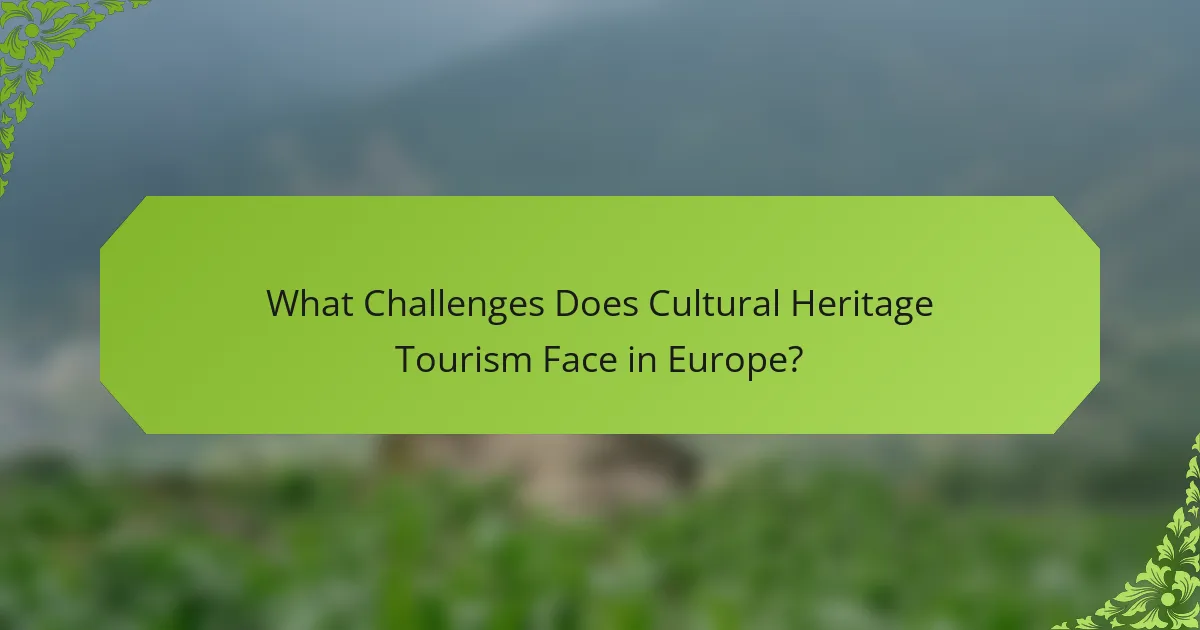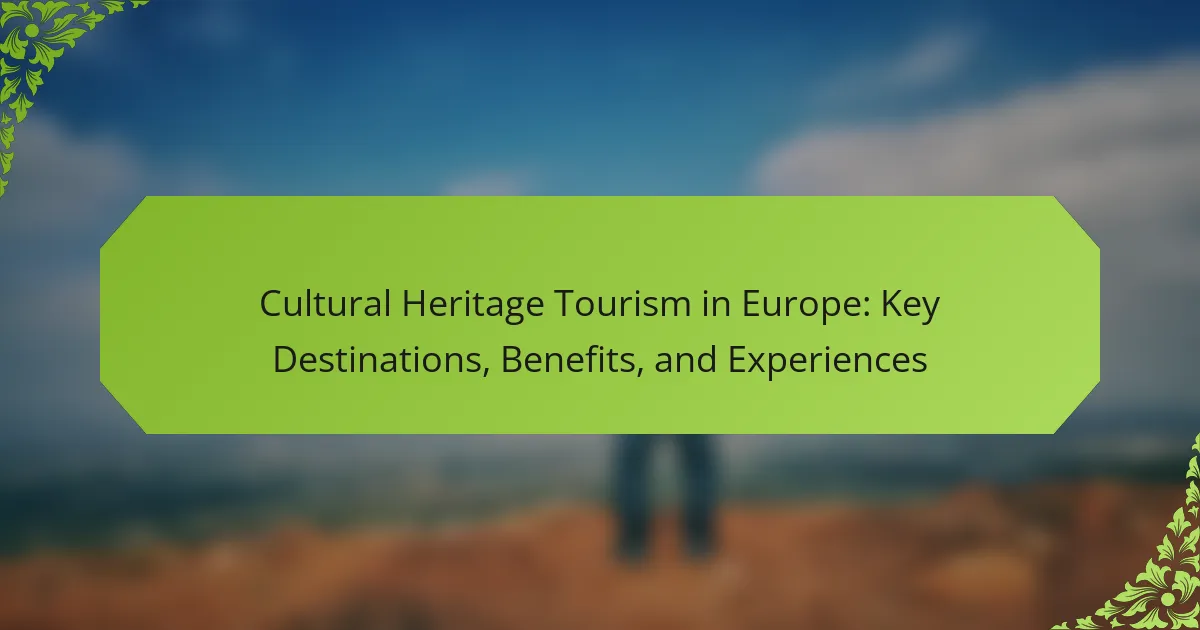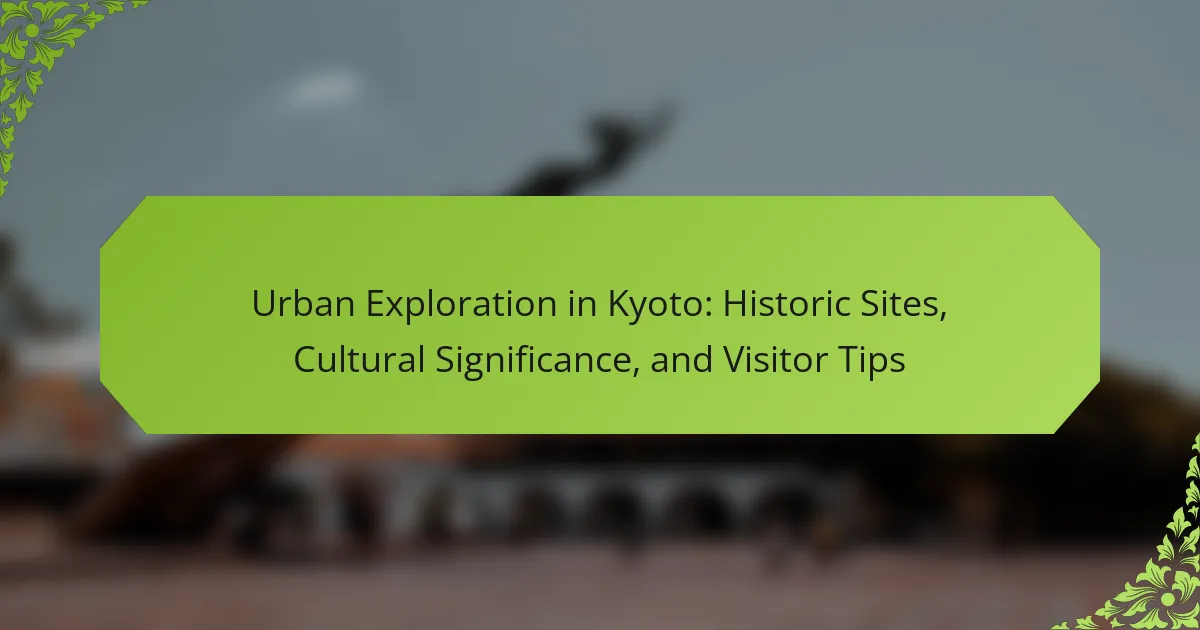Cultural heritage tourism in Europe offers enriching experiences that connect travelers to local histories and customs. Key destinations include Rome, Athens, and Paris, each boasting iconic landmarks and vibrant traditions. This form of tourism supports local economies and fosters community engagement while facing challenges like over-tourism and preservation issues. Travelers can expect immersive activities, guided tours, and authentic culinary experiences that enhance their appreciation for diverse cultures.

Which European Destinations Are Best Known for Cultural Heritage Tourism?
Cultural heritage tourism in Europe thrives in destinations like Rome, Athens, and Paris. These cities offer rich historical sites, museums, and cultural experiences that attract millions annually.
1. Rome: Known for its ancient ruins, including the Colosseum and the Vatican.
2. Athens: Home to iconic landmarks such as the Acropolis and Parthenon.
3. Paris: Famous for its art museums like the Louvre and historical architecture.
4. Florence: Renowned for Renaissance art and architecture, including the Duomo.
5. Istanbul: A blend of cultures with historical sites like Hagia Sophia and Topkapi Palace.
6. Prague: Offers a stunning medieval cityscape and the historic Charles Bridge.
These destinations enhance cultural heritage tourism through unique attributes like local traditions, culinary experiences, and festivals.
What Makes Rome a Top Cultural Heritage Destination?
Rome is a top cultural heritage destination due to its rich history, iconic landmarks, and profound artistic contributions. The city is home to the Colosseum, Vatican City, and countless museums that showcase its ancient civilization.
Visitors can experience the unique blend of history and modernity, with over 2,500 years of architecture and art. Rome’s cultural heritage tourism also offers benefits such as economic growth and preservation of historical sites.
Additionally, the city’s festivals and events, like the Rome Film Fest, enhance its vibrant cultural scene, attracting millions each year. As a result, Rome remains a pivotal destination for cultural heritage tourism in Europe.
How Does Paris Showcase Its Cultural Heritage?
Paris showcases its cultural heritage through iconic landmarks, museums, and vibrant arts. The city’s architecture, such as the Eiffel Tower and Notre-Dame, reflects its historical significance. Museums like the Louvre house invaluable art collections, attracting millions of visitors annually. Additionally, festivals celebrate local traditions, enhancing the cultural experience. Paris’s unique blend of history and modernity creates an immersive environment for cultural heritage tourism.
Which Unique Experiences Can Be Found in Athens?
Athens offers unique experiences that blend ancient history with vibrant modern culture. Visitors can explore the Acropolis, a UNESCO World Heritage site, which showcases classical architecture and historical significance. The city’s rich cultural scene includes traditional Greek music performances and local culinary tours that highlight regional flavors.
Additionally, the Plaka district provides a picturesque setting with its narrow streets, neoclassical buildings, and artisan shops. Art enthusiasts can enjoy contemporary galleries that contrast with Athens’ ancient heritage. These experiences collectively highlight Athens as a key destination for cultural heritage tourism in Europe.
What Role Does Barcelona Play in Cultural Heritage Tourism?
Barcelona plays a significant role in cultural heritage tourism by showcasing its rich history, architecture, and artistic heritage. The city is renowned for its unique blend of Gothic and Modernist architecture, exemplified by landmarks like the Sagrada Familia and Park Güell. These sites attract millions of visitors annually, contributing to the local economy and preserving cultural practices. Additionally, Barcelona hosts numerous festivals that celebrate its traditions, enhancing the cultural experience for tourists. The city’s vibrant arts scene, including museums and galleries, further enriches its appeal as a cultural heritage destination.
How Do Smaller Cities Contribute to Cultural Heritage Tourism in Europe?
Smaller cities significantly enhance cultural heritage tourism in Europe by offering unique experiences and rich histories. These destinations often feature lesser-known landmarks, local traditions, and authentic cultural interactions that larger cities may lack. For example, towns like Lucca in Italy and Gjirokastër in Albania showcase well-preserved architecture and vibrant local customs.
Smaller cities also provide a more intimate atmosphere, allowing visitors to engage deeply with the local culture. This fosters a sense of community and connection, enhancing the overall travel experience. Additionally, these locations often have lower tourist traffic, which can lead to a more relaxed exploration of cultural sites.
The economic impact of cultural heritage tourism in smaller cities is notable. It creates job opportunities, supports local artisans, and promotes sustainable practices. As a result, these cities can maintain their cultural heritage while benefiting economically from tourism.

What Are the Benefits of Engaging in Cultural Heritage Tourism?
Engaging in cultural heritage tourism provides numerous benefits, including educational experiences, community support, and preservation of traditions. Travelers gain insights into local histories and customs, fostering appreciation for diverse cultures. This tourism form also stimulates local economies by creating jobs and supporting small businesses. Additionally, it encourages conservation efforts, ensuring that cultural sites and practices are maintained for future generations.
How Does Cultural Heritage Tourism Support Local Economies?
Cultural heritage tourism significantly boosts local economies by attracting visitors and generating revenue. This form of tourism fosters job creation, supports local artisans, and encourages the preservation of cultural sites.
In Europe, destinations like Florence and Athens thrive economically through heritage tourism, which brings millions in visitor spending annually. For instance, Florence sees approximately 16 million tourists each year, contributing over 2 billion euros to the local economy.
Moreover, cultural heritage tourism promotes sustainable development by encouraging communities to invest in their cultural assets. This results in improved infrastructure and services, benefiting both tourists and residents.
As a unique attribute, local festivals and events tied to cultural heritage create additional revenue streams, enhancing the overall economic impact of tourism in these regions.
What Impact Does Cultural Heritage Tourism Have on Preservation Efforts?
Cultural heritage tourism significantly enhances preservation efforts by generating funds and raising awareness. Increased visitor interest leads to better conservation practices and community engagement in protecting cultural sites. For instance, UNESCO World Heritage Sites often receive financial support for maintenance through tourism revenues. This financial influx directly contributes to the restoration and preservation of historical landmarks. As a result, local communities become more invested in maintaining their cultural heritage, ensuring its survival for future generations.
Why Is Cultural Exchange Important in Heritage Tourism?
Cultural exchange enhances heritage tourism by fostering mutual understanding and appreciation among diverse communities. It promotes authentic experiences that benefit both visitors and local cultures. Engaging with local traditions enriches travelers’ experiences while supporting the preservation of cultural heritage. This reciprocal relationship encourages sustainable tourism practices, ensuring that cultural sites remain vibrant and relevant.
How Does Cultural Heritage Tourism Enhance Visitor Experiences?
Cultural heritage tourism enhances visitor experiences by providing immersive encounters with history and local traditions. Engaging with authentic cultural practices fosters deeper connections and understanding. Key benefits include increased appreciation for diverse cultures, support for local economies, and preservation of historical sites. Visitors gain unique insights through guided tours, workshops, and festivals that showcase regional heritage. This form of tourism often promotes sustainable practices, ensuring that cultural legacies are maintained for future generations.

What Types of Experiences Can Travelers Expect from Cultural Heritage Tourism?
Travelers can expect immersive and enriching experiences from cultural heritage tourism. This form of tourism offers opportunities to engage with local traditions, explore historical sites, and participate in authentic cultural practices.
Key experiences include guided tours of UNESCO World Heritage sites, workshops with local artisans, and participation in traditional festivals. For instance, visiting the ancient ruins of Rome allows travelers to connect with the history of the Roman Empire.
Additionally, cultural heritage tourism promotes community interaction, providing insights into local lifestyles and customs. Travelers often enjoy tasting regional cuisines, which reflect the area’s cultural identity.
This tourism type not only fosters appreciation for heritage but also supports local economies, making it a sustainable choice for conscious travelers.
Which Cultural Events Should Tourists Attend in Europe?
Tourists should attend renowned cultural events such as the Venice Carnival, Edinburgh Festival Fringe, and Oktoberfest. These events showcase unique traditions, art, and local cuisine, enriching the cultural heritage tourism experience.
1. Venice Carnival | Celebrates Venetian traditions | February
2. Edinburgh Festival Fringe | World’s largest arts festival | August
3. Oktoberfest | Iconic beer festival in Munich | September-October
4. La Tomatina | Famous tomato-throwing festival | Last Wednesday of August
5. Bastille Day | French national holiday with parades | July 14
6. Christmas Markets | Festive markets across Europe | Late November-December
How Can Travelers Engage with Local Cultures During Their Visits?
Travelers can engage with local cultures by participating in authentic experiences that highlight heritage. Key activities include visiting historical sites, attending local festivals, and participating in traditional crafts. These interactions foster cultural appreciation and support local economies. For example, cooking classes in Italy allow travelers to learn about regional cuisine while connecting with locals. Engaging with artisans in Spain can provide insight into traditional techniques and practices. Such immersive experiences enhance understanding and respect for diverse cultures.
What Are the Most Popular Forms of Cultural Heritage Experiences?
Cultural heritage experiences in Europe include guided tours, local festivals, historical reenactments, culinary experiences, and museum exhibitions. These activities immerse travelers in the rich history and traditions of various regions. Guided tours often highlight significant landmarks, while local festivals showcase regional customs and celebrations. Historical reenactments provide insight into past events, and culinary experiences allow visitors to taste traditional dishes. Museum exhibitions offer educational opportunities to explore artifacts and art from different cultures.

How Is Cultural Heritage Tourism Perceived Differently Across Europe?
Cultural heritage tourism is perceived differently across Europe due to varying historical contexts and cultural values. Northern Europe emphasizes preservation and education, while Southern Europe often focuses on tourism’s economic benefits.
In countries like Italy and Spain, cultural heritage sites drive significant tourism revenue, highlighting their economic value. In contrast, Scandinavian nations prioritize sustainability and community engagement, viewing heritage as a shared responsibility.
For example, France promotes its cultural heritage through festivals and events, enhancing local identity and pride. Meanwhile, Eastern European nations are increasingly recognizing the potential of their rich histories to attract visitors, balancing preservation with modernization.
Overall, perceptions of cultural heritage tourism reflect diverse priorities, shaping unique experiences for travelers across the continent.
What Are the Regional Variations in Cultural Heritage Tourism Experiences?
Cultural heritage tourism experiences vary significantly across Europe, influenced by local traditions and historical contexts. Destinations like Rome focus on ancient architecture, while Paris emphasizes art and culture. In contrast, Eastern European countries showcase folk traditions and unique customs. Each region offers distinct benefits, such as enhanced community engagement and economic growth. The diversity in experiences enriches travelers’ understanding of Europe’s cultural heritage.
How Do Cultural Heritage Tourism Trends Differ Between Western and Eastern Europe?
Cultural heritage tourism trends differ significantly between Western and Eastern Europe. Western Europe focuses on established historical sites and luxury experiences, while Eastern Europe emphasizes emerging destinations and affordability.
Western Europe boasts renowned landmarks like the Eiffel Tower and the Colosseum, attracting affluent tourists seeking rich cultural experiences. In contrast, Eastern Europe offers unique cultural heritage sites, such as the medieval towns of Poland and the historical architecture of Romania, appealing to budget-conscious travelers.
Additionally, Western Europe often promotes tourism through well-funded marketing campaigns, while Eastern Europe relies on grassroots initiatives. This results in a more diverse range of experiences in Eastern Europe, including local festivals and traditions that highlight regional heritage.
As a result, travelers in Western Europe may prioritize comfort and convenience, whereas those in Eastern Europe often seek authentic cultural immersion. This distinction shapes the overall landscape of cultural heritage tourism across the continent.

What Challenges Does Cultural Heritage Tourism Face in Europe?
Cultural heritage tourism in Europe faces challenges such as over-tourism, preservation issues, and economic disparities. Over-tourism leads to environmental degradation and impacts local communities negatively. Preservation of historical sites is often compromised due to insufficient funding and maintenance. Economic disparities can create unequal access to cultural experiences, limiting the benefits to certain demographics.
How Do Overcrowding and Sustainability Issues Affect Heritage Sites?
Overcrowding and sustainability issues significantly harm heritage sites by degrading their cultural and physical integrity. Increased visitor numbers lead to wear and tear on structures, while inadequate management strains local resources. For instance, the Colosseum in Rome faces damage from millions of annual visitors, necessitating strict visitor limits. Sustainability efforts must balance tourism growth with preservation, ensuring heritage sites remain intact for future generations.
What Are the Common Misconceptions About Cultural Heritage Tourism?
Cultural heritage tourism is often misunderstood, leading to several misconceptions. Many believe it only involves visiting historical sites, neglecting its broader scope, which includes cultural experiences and interactions with local communities. Another misconception is that it primarily benefits tourists rather than local economies; in reality, it fosters sustainable development and preserves cultural identities. Additionally, some think cultural heritage tourism is only for the elite, while it actually offers diverse experiences accessible to all. Lastly, there is a belief that it can harm local cultures, but when managed responsibly, it can enhance cultural appreciation and conservation.

What Strategies Can Enhance Cultural Heritage Tourism Experiences?
Engaging cultural heritage tourism experiences can be enhanced through authentic storytelling, immersive activities, and community involvement. Authentic storytelling connects visitors to the local culture, enriching their understanding. Immersive activities, such as hands-on workshops, allow tourists to experience traditions firsthand. Community involvement fosters deeper connections, as local residents share their heritage, creating memorable interactions. These strategies not only enhance visitor satisfaction but also promote sustainable tourism practices.
How Can Tour Operators Improve Cultural Heritage Tours?
Tour operators can enhance cultural heritage tours by focusing on authentic experiences, local partnerships, and sustainable practices. Engaging local communities ensures that tours reflect genuine cultural narratives. Operators should prioritize immersive activities, such as workshops or guided storytelling sessions, to deepen visitors’ connections to the heritage. Additionally, incorporating technology, like augmented reality, can enrich the learning experience. Lastly, promoting responsible tourism helps preserve heritage sites while benefiting local economies.
What Best Practices Should Travelers Follow When Participating in Cultural Heritage Tourism?
Travelers should respect local customs, engage with the community, and support local businesses when participating in cultural heritage tourism. Understanding cultural significance enhances the experience and fosters positive interactions.
1. Research local customs and traditions before visiting.
2. Participate in community events and workshops.
3. Choose locally-owned accommodations and restaurants.
4. Avoid disruptive behavior during cultural ceremonies.
5. Share experiences respectfully on social media.
6. Provide feedback to enhance future cultural tourism efforts.
How Can Local Communities Be Involved in Cultural Heritage Tourism Initiatives?
Local communities can significantly enhance cultural heritage tourism initiatives by actively participating in planning and execution. Engaging local stakeholders fosters authentic experiences and preserves cultural identity.
Community involvement can take various forms, such as organizing cultural events, showcasing local crafts, and offering guided tours that highlight historical significance. These actions not only promote tourism but also empower residents and stimulate local economies.
For instance, in Italy, local artisans collaborate with tourism boards to create workshops that allow visitors to learn traditional crafts. This unique attribute enriches the tourist experience while ensuring the sustainability of cultural practices.
As a result, fostering collaboration between local communities and tourism stakeholders is essential for creating meaningful cultural heritage tourism initiatives that benefit both visitors and residents.
What Common Mistakes Do Tourists Make in Cultural Heritage Tourism?
Tourists often make mistakes in cultural heritage tourism by not researching local customs, leading to cultural insensitivity. They may also overlook lesser-known sites, missing authentic experiences. Additionally, failing to engage with local communities can result in superficial visits. Lastly, ignoring sustainability practices can harm heritage sites.



